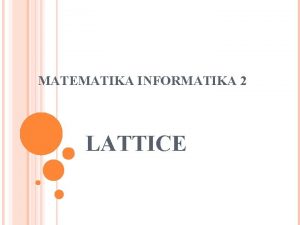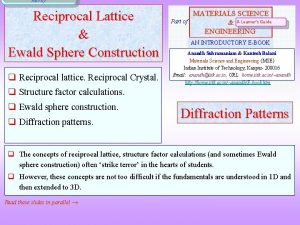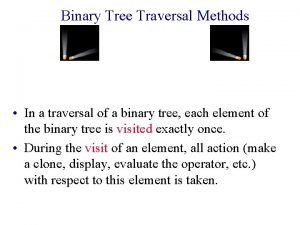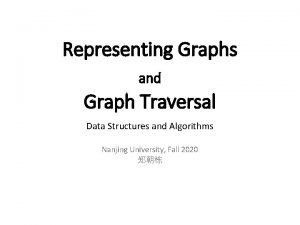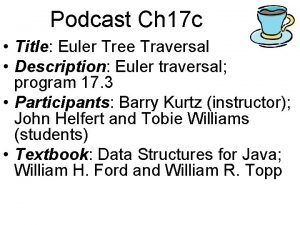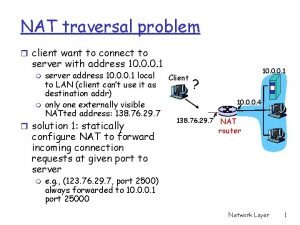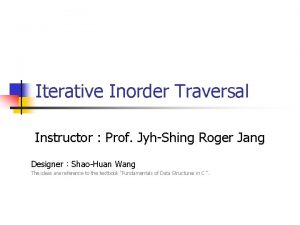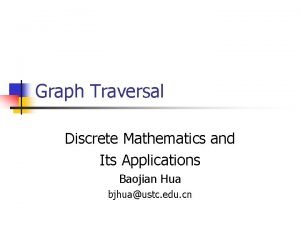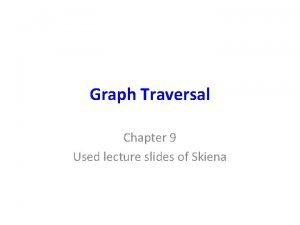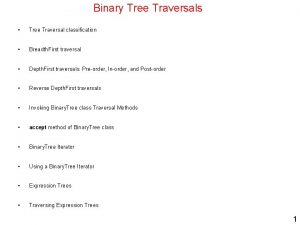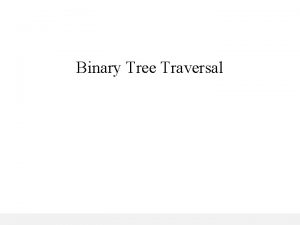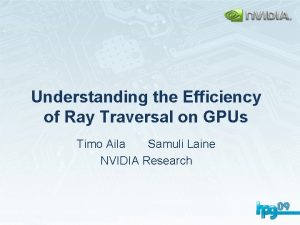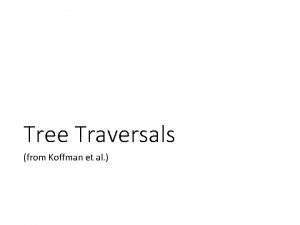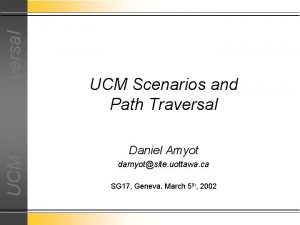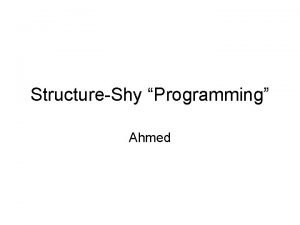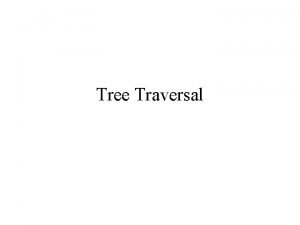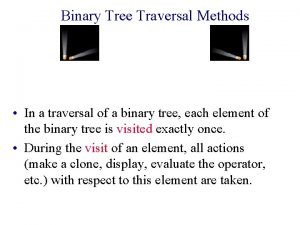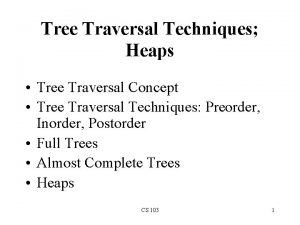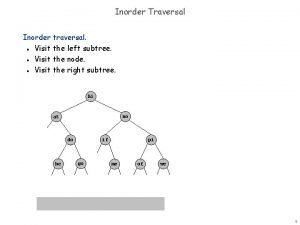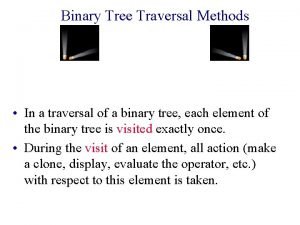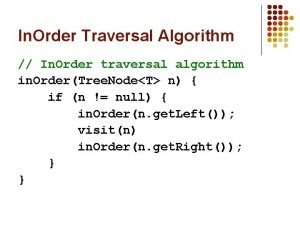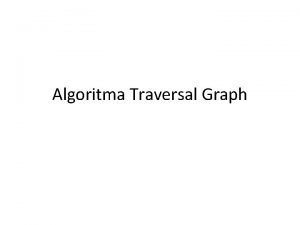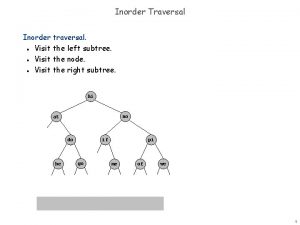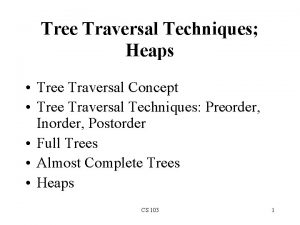Examples Lattice Construction and Lattice Traversal Examples Verification
















- Slides: 16

Examples Lattice Construction and Lattice Traversal Examples

Verification of Code with Library Functions • int main(void) { int x = 45; int y = 18; int g = gcd(x, y); assert(g <= x); } int gcd(int x, int y) { int tmp; while (y!=0){ tmp = x%y; x = y; y = tmp; } return x; } 2

Refinement via Lattice of a Function • The model: o 3 facts of modulo operator from slide 2 o fact 3 => fact 1, fact 3 => fact 2 o Subset lattice: 8 elements = all the possible subset of poset {fact 1, fact 2, fact 3} • To simple model, by: 3

Refinement via Lattice of a Function • The model: o 3 facts of modulo operator from slide 2 o fact 3 => fact 1, fact 3 => fact 2 o Subset lattice: 8 elements = all the possible subset of poset {fact 1, fact 2, fact 3} • To simple model, by: o Remove Contradictions: fact 1 + fact 2 is false 3

Refinement via Lattice of a Function • The model: o 3 facts of modulo operator from slide 2 o fact 3 => fact 1, fact 3 => fact 2 o Subset lattice: 8 elements = all the possible subset of poset {fact 1, fact 2, fact 3} • To simple model, by: o Remove Contradictions: fact 1 + fact 2 is false o Remove Duplications: fact 3 to replace the rest 3

Refinement via Lattice of a Function • The model: o 3 facts of modulo operator from slide 2 o fact 3 => fact 1, fact 3 => fact 2 o Subset lattice: 8 elements = all the possible subset of poset {fact 1, fact 2, fact 3} • To simple model, by: o Remove Contradictions: fact 1 + fact 2 is false o Remove Duplications: fact 3 to replace the rest 3

Refinement via Lattice of a Function • The model: o 3 facts of modulo operator from slide 2 o fact 3 => fact 1, fact 3 => fact 2 o Subset lattice: 8 elements = all the possible subset of poset {fact 1, fact 2, fact 3} • To simple model, by: o Remove Contradictions: fact 1 + fact 2 is false o Remove Duplications: fact 3 to replace the rest • Output: New semilattice that is a reduced lattice of the original subset lattice 3

Lattice Traversal for N=2 • gcd with constants • two modulo op. 2 LRA lattices (traversal order: L 2, L 1) first mod second mod 1 = {}, mod 2 = {} Result: Note: traversal according to general version + optimization for different occurrences of the same function. Additional optimizations are in the paper. int gcd(int x, int y) { int tmp; while (y!=0){ tmp = x%y; x = y; y = tmp; } return x; } int main(void) { int x = 45; int y = 18; int g = gcd(x, y); assert(g <= x); } 4

Lattice Traversal for N=2 • gcd with constants • two modulo op. 2 LRA lattices (traversal order: L 2, L 1) first mod second mod 1 = {f 1}, mod 2 = {f 1} Note: traversal according to general version + optimization for different occurrences of the same function. Additional optimizations are in the paper. int gcd(int x, int y) { int tmp; while (y!=0){ tmp = x%y; x = y; y = tmp; } return x; } int main(void) { int x = 45; int y = 18; int g = gcd(x, y); assert(g <= x); } 4

Lattice Traversal for N=2 • gcd with constants • two modulo op. 2 LRA lattices (traversal order: L 2, L 1) first mod second mod 1 = {}, mod 2 = {} Result: SAT CEX: x 1=45, y 1=18, tmp 1=50, x 2=18, y 2=50, tmp 2=40, x 3=50, y 3=40 Note: traversal according to general version + optimization for different occurrences of the same function. Additional optimizations are in the paper. int gcd(int x, int y) { int tmp; while (y!=0){ tmp = x%y; x = y; y = tmp; } return x; } int main(void) { int x = 45; int y = 18; int g = gcd(x, y); assert(g <= x); } 4

Lattice Traversal for N=2 • gcd with constants • two modulo op. 2 LRA lattices (traversal order: L 2, L 1) first mod second mod 1 = {f 1}, mod 2 = {f 1} Result: UNSAT Note: UNSAT when called from main with x=45, y=18, not in general! Note: traversal according to general version + optimization for different occurrences of the same function. Additional optimizations are in the paper. int gcd(int x, int y) { int tmp; while (y!=0){ tmp = x%y; x = y; y = tmp; } return x; } int main(void) { int x = 45; int y = 18; int g = gcd(x, y); assert(g <= x); } 4

Lattice Traversal for N=2 • gcd with constants • two modulo op. 2 LRA lattices (traversal order: L 2, L 1) first mod second mod 1 = {}, mod 2 = {f 1} Try now the other successor of ⊥ of L 1 (of operator mod 1) Note: traversal according to general version + optimization for different occurrences of the same function. Additional optimizations are in the paper. int gcd(int x, int y) { int tmp; while (y!=0){ tmp = x%y; x = y; y = tmp; } return x; } int main(void) { int x = 45; int y = 18; int g = gcd(x, y); assert(g <= x); } 4

Lattice Traversal for N=2 • gcd with constants • two modulo op. 2 LRA lattices (traversal order: L 2, L 1) first mod second mod 1 = {f 2}, mod 2 = {f 1} Note: traversal according to general version + optimization for different occurrences of the same function. Additional optimizations are in the paper. int gcd(int x, int y) { int tmp; while (y!=0){ tmp = x%y; x = y; y = tmp; } return x; } int main(void) { int x = 45; int y = 18; int g = gcd(x, y); assert(g <= x); } 4

Lattice Traversal for N=2 • gcd with constants • two modulo op. 2 LRA lattices (traversal order: L 2, L 1) first mod second mod 1 = {f 2}, mod 2 = {f 1} Result: SAT CEX: x 1=45, y 1=18, tmp 1=50, x 2=18, y 2=50, tmp 2=60, x 3=50, y 3=60 Note: traversal according to general version + optimization for different occurrences of the same function. Additional optimizations are in the paper. int gcd(int x, int y) { int tmp; while (y!=0){ tmp = x%y; x = y; y = tmp; } return x; } int main(void) { int x = 45; int y = 18; int g = gcd(x, y); assert(g <= x); } 4

Lattice Traversal for N=2 • gcd with constants • two modulo op. 2 LRA lattices (traversal order: L 2, L 1) first mod second mod mod 1 = {f 3}, mod 2 = {f 3} Note: traversal according to general version + optimization for different occurrences of the same function. Additional optimizations are in the paper. int gcd(int x, int y) { int tmp; while (y!=0){ tmp = x%y; x = y; y = tmp; } return x; } int main(void) { int x = 45; int y = 18; int g = gcd(x, y); assert(g <= x); } 4

Lattice Traversal for N=2 • gcd with constants • two modulo op. 2 LRA lattices (traversal order: L 2, L 1) first mod second mod mod 1 = {f 3}, mod 2 = {f 3} Result: UNSAT Note: traversal according to general version + optimization for different occurrences of the same function. Additional optimizations are in the paper. int gcd(int x, int y) { int tmp; while (y!=0){ tmp = x%y; x = y; y = tmp; } return x; } int main(void) { int x = 45; int y = 18; int g = gcd(x, y); assert(g <= x); } 4
 Construction verification
Construction verification Lattice matematika diskrit
Lattice matematika diskrit Ewald sphere construction
Ewald sphere construction Binary tree traversal techniques
Binary tree traversal techniques Traversal algorithm in distributed system
Traversal algorithm in distributed system Graph traversal in data structure
Graph traversal in data structure Graph traversal in data structure
Graph traversal in data structure Euler tour traversal
Euler tour traversal Nat traversal problem solution
Nat traversal problem solution Iterative inorder
Iterative inorder Bfs and dfs in discrete mathematics
Bfs and dfs in discrete mathematics Graph traversal methods
Graph traversal methods Reverse binary tree
Reverse binary tree Which of the following tree traversal holds for clr
Which of the following tree traversal holds for clr Huffman tree visualization
Huffman tree visualization Understanding the efficiency of ray traversal on gpus
Understanding the efficiency of ray traversal on gpus Inorder traversal visualization
Inorder traversal visualization

